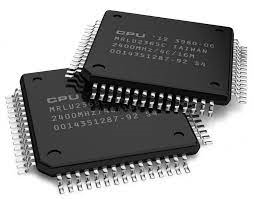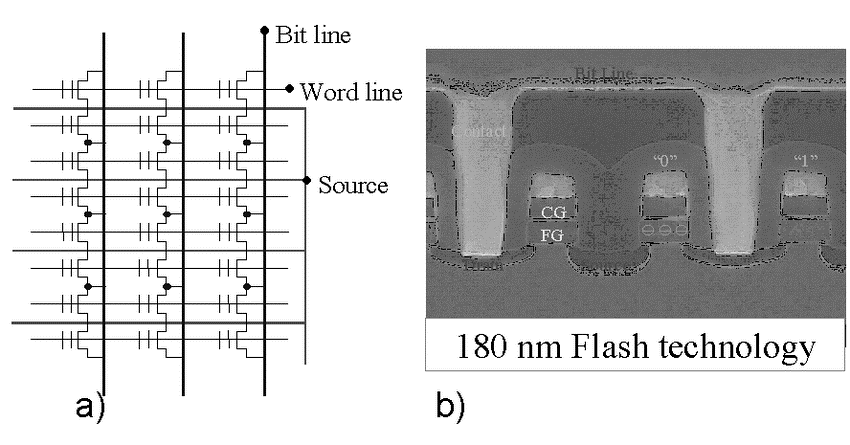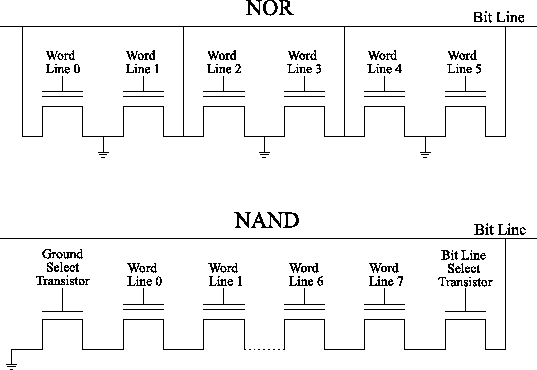What is flash memory?
Flash memory, commonly known as flash storage, is a non-volatile memory. In electronics products and enterprise software, flash memory is frequently used for storage and transfer.

In-memory processing devices use flash memory to enhance the productivity and capacity of the system for handling and analyzing massive amounts of data.
NOR or NAND gates combinedly make up a flash memory chip. Intel invented NOR as a sort of memory location in 1988. The NOR gate connection supports full addresses, data buses, and unpredicted access to any memory area. The shelf life of NOR flash is 10,000 to 1,000,000 write/erase cycles.
Toshiba developed NAND just a year after NOR was released. It's faster, costs less per bit, takes up less chip space per cell, and is more resilient. A NAND gate has a shelf life of about 100,000 write/erase cycles.
Memory cards, USB flash drives, solid-state drives, feature phones, cellphones, and similar products use the NAND type for basic data transmission and storage.
Pcs, PDAs, digital music players, digital cameras, cell phones, synthesizers, video games, scientific equipment, industrial robots, and medical devices all use flash memory. Although flash memory has a quick read access time, it is slower than static RAM or ROM. Because of its physical shock resilience, it is chosen over hard discs in portable devices.
History of origin
Dr Fujio Masuoka devised the flash memory when working for Toshiba in 1984. Thus, according to Toshiba, Dr Masuoka's colleague, Mr Shoji Ariizumi offered the name "Flash" because the erasing procedure of the system memory reminds him of a camera flash.
NOR-based flash has slow erase and rewrite speeds, but it features a complete address/data (memory) connectivity that permits access to any place at any time. This makes it ideal for storing program code that has to be changed rarely, such as a computer's BIOS or set-top box software.
Flash memory working principle
Data is stored in a flash memory array of floating gate transistors. Every single-level cell (SLC) gadget unit contains only one bit of data. And over one bit can be stored per cell in multi-level cell (MLC) and triple-level cell (TLC) gadgets.
The floating gate can be conductive or non-conductive.
A flash memory design comprises a memory array stacked with multiple flash cells. A simple flash memory cell comprises a storage transistor that has both a control and a floating gate and is isolated from the rest of the device by a thin dielectric or oxide layer. The floating gate, which regulates the current flow, stores the electrical charge. Electrons are added or removed from the floating gate to change the storage transistor's peak value. The voltage affects whether a cell is coded as a one or a zero.
Types of flash memory
1. NOR flash

Every cell in a NOR flash circuit has one end linked to the ground and another end linked to a bit line. Since it behaves like a NOR gate, this design is renamed "NOR flash": when one of the term lines is pulled high, the matching storage transistor pulls the output bit line low. For embedded systems that need a distinct non-volatile memory chip, NOR flash remains the best technology. Because NOR devices have low read response times, they can be used for direct software operations and data storage in a single memory item.
2. NAND flash
Although NAND memory employs floating-gate transistors, these are coupled in a method that mimics a NAND gate, with many transistors linked in series and the bit line pushed low only if all the word lines are tried to pull high. These groupings are then joined to a NOR-style bit line array by several extra transistors, similar to how single transistors are joined in NOR flash.

Replacement of only one transistor with serial-linked groups provides an extra level of dealing compared to NOR flash. NAND flash addresses storage by page, text, and bit, while NOR flash addresses memory by page, text, and bit. Bit-serial applications benefit from bit-level addressing since they only access one bit simultaneously. Implementation programs, on the other hand, need instantaneous control of every bit of a text. These needs addressing in the given text. Both bit and word addressing modes are feasible with either NOR or NAND storage.
Flash memory form factors
A silicon substrate is used in flash-based devices. Solid-state devices, as they are often known, are extensively applied in consumer electronics and business data storage systems.
The Solid-State Storage Initiative has recognized three different SSD form factors:
- Solid-state drives (SSDs) that may be installed in the same slots as classic electromechanical hard disc drives (HDDs). SSDs have a similar design to integrated circuits.
- Solid-state cards with a standard card form factor, such as Peripheral Component Interconnect Express, that are mounted on a printed circuit board (PCIe).
- Solid-state modules that fit in a dual inline memory module (DIMM) or small outline dual inline memory module using a standard HDD interface, such as the Serial Advanced Technology Attachment (SATA).
Difference between NOR and NAND flash
NOR and NAND flash differ in two ways: the connectivity between individual memory cells are distinct, as are the interfaces for reading and writing the memory. NAND permits only page access, whereas NOR allows random access.
The architecture of the links between memory cells gives NOR and NAND flash their names. Cells in NOR flash are linked in parallel to the bit lines, enabling cells to be read and coded. In a CMOS NOR gate, the parallel connection of cells mirrors the parallel connection of transistors. Cells in NAND memory are linked in series, similar to CMOS NAND gates. Because series connections take up less space as compared to parallel connections, the price of NAND memory is reduced. It does not, on its own, protect you from harm.
Advantage and Disadvantage of flash memory
The following are some of the benefits of flash memory:
- Flash memory is the less costly type of semiconductor storage memory; with the exception of dynamic random-access memory (DRAM) and static random-access memory (SRAM), it is non-volatile, runs at less power, and can be removed in huge blocks.
- NOR memory has faster random read rates, but NAND flash has faster serial read and write speeds.
- Older magnetic device, such as HDDs and tape, are substantially slower than SSDs using NAND flash memory chips.
- Flash SSDs also use less energy and emit less heat than hard disc drives.
Application of flash memory
Serial flash
Serial flash is a tiny, low-power flash memory that only allows sequential access to the files, rather than assessing individual bytes. SPI (Serial Peripheral Interface Bus) is a popular method for connecting to a computer. Serial flash memories require less wires on the PCB when integrated into an embedded system than parallel flash memories since they send and receive data one bit at a time. This might result in less board area, less power usage, and a lower total system cost.
Flash memory as a replacement for hard drives
The use of flash memory as a hard drive alternative is a relatively recent application. Solid-state drives (SSDs) are appealing when considered speed, noise, energy consumption, and stability since flash memory does not have the physical restrictions and inefficiencies of hard drives. Flash drives are becoming more popular as backup storage devices for mobile devices, and they are also being utilized to replace hard drives in high-performance desktop PCs and some servers with RAID and SAN designs.
There are still several flaws with flash-based SSDs that make them unappealing. Flash memory continues to be substantially more expensive per GB than hard drives. Also, flash memory has a limited number of P/E (program/erase) cycles, but this appears to be below controlled now that flash-based SSD lifetimes are nearing those of hard drives.
Furthermore, erased files on SSDs can persist indefinitely before being replaced by new data; erasure or shredding procedures or software that work well on magnetic hard disc drives have no impact on SSDs, jeopardizing security and forensic scrutiny.
Flash memory as RAM
As of 2012, there have been attempts to employ flash memory instead of DRAM as the primary computer memory.
Unlike RAM, flash memory is non-volatile and can save data even when the power is turned off. The performance of flash memory is much slower than that of any form of RAM. Flash is utilized for store memory in products such as SD cards, USB drives, and SSDs because of its low energy consumption, long life, and low price.